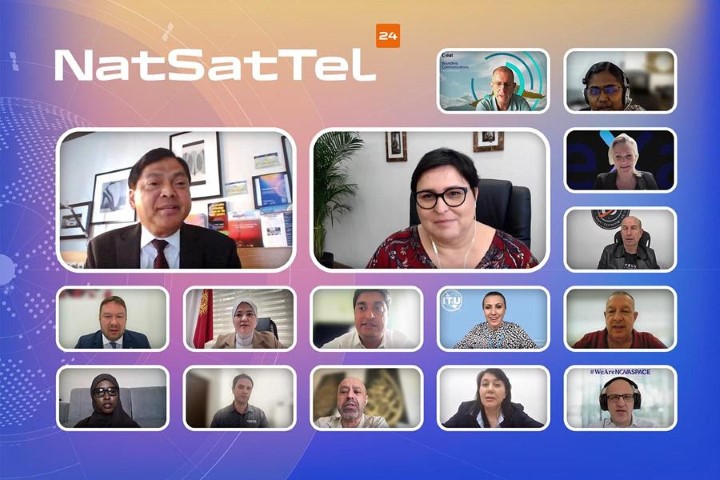NatSatTel 2024 HighKey Trends in the Global Satellite Communications Industry
Los Angeles, Calif., June 19, 2024 - Intersputnik and Satellite Markets and Research hosted the NatSatTel 2024 international conference on "Innovative Technologies and Services in the Global Satellite Industry" on June 11, 2024. The conference speakers included representatives of leading players and analysts of the satellite communications market.
 |
A separate conference session with the participation of the International Telecommunication Union (ITU) discussed gender equality and the involvement of girls in the processes of technological and digital development of humankind. The online conference NatSatTel-2024 brought together more than 150 people from 38 countries of Africa, the Asia-Pacific region, the Middle East, North and South America, Central Asia and Europe.
Ksenia Drozdova, Director General of Intersputnik, addressed the conference participants with a welcoming speech. She emphasized the role of Intersputnik in uniting national, regional and international players in the satellite communications industry with the aim of improving the quality of life and achieving the UN Sustainable Development Goals (SDGs). Virgil Labrador, Editor-in-Chief, Satellite Markets & Research, moderated the conference.
Vivek Prasad, Senior Analyst of Analysys Mason, presented the key trends in the development of the satellite communications industry. First of all, this is the use of High Throughput Satellites (HTS) with flexible payloads, which reduce the cost of traffic transmitted. Industry development will drive the demand from 5G market players as the ecosystem matures. Artificial intelligence (AI) will allow flexible management of satellite network resources, increasing the demand and competitiveness. After 2030, AI will be deployed in most satellite networks for use in the majority of customer scenarios.
Vivek Prasad also noted such a factor as the beginning of mass production of flat antennas. In the coming years, this will reduce their price, which will open up new markets for satellite communications. For non-geostationary systems, the key development factor will be the use of inter-satellite laser communication channels and optimization of networks due to a smaller number of gateways.
At a session on non-geostationary systems (NGSO Constellations: Enabling Key Applications), Jaume Sanpera, CEO at Sateliot, Majdi Atout, Senior Consultant IoT at APPLIOT, and Andrey Kirillovich, Director of Strategy, Marketing and Business Development at Intersputnik, discussed the opportunities for the market of non-geostationary constellations for satellite broadband communications and satellite Internet of Things.
In his speech, Andrey Kirillovich noted the advantages of Intersputnik, which could integrate any satellite assets, including non-geostationary systems, into its activities. He drew attention to the fact that for many countries it was extremely important to develop their proprietary satellite communications industry, investing in their own economy and hosting of technologies, thereby solving national problems in meeting the needs of connecting people on domestic market.
At the “Game Changing Technologies and Solutions” session representatives of satellite equipment vendors presented new solutions for the satellite market. The speakers of the session included Hagay Katz, Chief Product and Marketing Officer at Gilat Satellite Networks, Vaibhav Maigow, VP-International Division at Hughes, and Alvaro Sanchez, CEO at Integrasys.
The round table “Girls In ICT. Leadership (Satellite)” was moderated by Natalia Mochu, Head of the ITU Regional Office. She spoke about ITU's policy to inspire and encourage girls to pursue their ICT education and careers with the aim to fully and effectively participate in digitalization and technological development. Natalia Mochu believes that one of the most effective methods of such encouragement is role models, success stories told by female leaders who continue a successful ICT career. Especially in such a complex sector as satellite communications. The round table included the following speakers: Caroline De Vos, COO and Founding Partner at neXat; Revathi Manneppalli, Member of the ITU Radio Regulations Board, Joint Wireless Adviser at the Ministry of Communications of the Republic of India; Sahiba Hasanova, Member of the ITU Radio Regulations Board, Leading Adviser at the Ministry of Digital Development and Transport of the Republic of Azerbaijan; Aichurok Maralbek, Chief Officer of the Spectrum Management Department at the Service for Regulation and Supervision in the Communications Industry under the Ministry of Digital Development of the Kyrgyz Republic; Khadra Farah Mohamed, Telecom Engineer at DalKom Somalia.
NatSatTel has once again confirmed its status as one of the leading industry forums, where experts share their views on the opportunities of the industry and obtain market intel from the leading industry analytical agencies; vendors present the latest technologies that are changing the core of the satellite industry; regional and national players discuss solutions for current challenges in digital inclusion and connecting the unconnected.
NatSatTel demonstrates the capabilities of satellite technologies to solve global humanitarian problems and reach the SDGs. Intersputnik, being an international organization that fully supports the principles declared by the UN and ITU, is always ready to provide a NatSatTel platform for open and equal communication between the world's leading professionals and experts.
 |
 |





